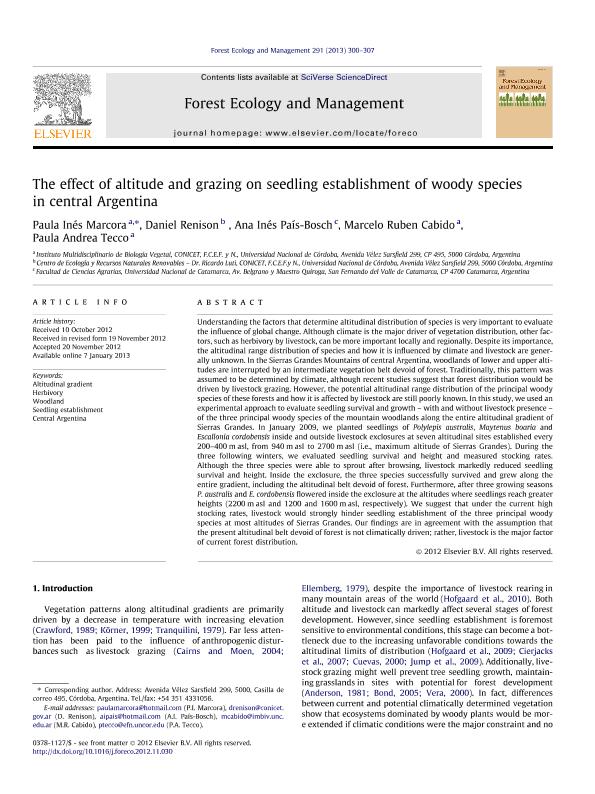Artículo
The effect of altitude and grazing on seedling establishment of woody species in central Argentina
Marcora, Paula Inés ; Renison, Daniel
; Renison, Daniel ; Pais Bosch, Ana Ines
; Pais Bosch, Ana Ines ; Cabido, Marcelo Ruben
; Cabido, Marcelo Ruben ; Tecco, Paula Andrea
; Tecco, Paula Andrea
 ; Renison, Daniel
; Renison, Daniel ; Pais Bosch, Ana Ines
; Pais Bosch, Ana Ines ; Cabido, Marcelo Ruben
; Cabido, Marcelo Ruben ; Tecco, Paula Andrea
; Tecco, Paula Andrea
Fecha de publicación:
03/2013
Editorial:
Elsevier Science
Revista:
Forest Ecology And Management
ISSN:
0378-1127
Idioma:
Inglés
Tipo de recurso:
Artículo publicado
Clasificación temática:
Resumen
Understanding the factors that determine altitudinal distribution of species is very important to evaluate the influence of global change. Although climate is the major driver of vegetation distribution, other factors, such as herbivory by livestock, can be more important locally and regionally. Despite its importance, the altitudinal range distribution of species and how it is influenced by climate and livestock are generally unknown. In the Sierras Grandes Mountains of central Argentina, woodlands of lower and upper altitudes are interrupted by an intermediate vegetation belt devoid of forest. Traditionally, this pattern was assumed to be determined by climate, although recent studies suggest that forest distribution would be driven by livestock grazing. However, the potential altitudinal range distribution of the principal woody species of these forests and how it is affected by livestock are still poorly known. In this study, we used an experimental approach to evaluate seedling survival and growth – with and without livestock presence – of the three principal woody species of the mountain woodlands along the entire altitudinal gradient of Sierras Grandes. In January 2009, we planted seedlings of Polylepis australis, Maytenus boaria and Escallonia cordobensis inside and outside livestock exclosures at seven altitudinal sites established every 200–400 m asl, from 940 m asl to 2700 m asl (i.e., maximum altitude of Sierras Grandes). During the three following winters, we evaluated seedling survival and height and measured stocking rates. Although the three species were able to sprout after browsing, livestock markedly reduced seedling survival and height. Inside the exclosure, the three species successfully survived and grew along the entire gradient, including the altitudinal belt devoid of forest. Furthermore, after three growing seasons P. australis and E. cordobensis flowered inside the exclosure at the altitudes where seedlings reach greater heights (2200 m asl and 1200 and 1600 m asl, respectively). We suggest that under the current high stocking rates, livestock would strongly hinder seedling establishment of the three principal woody species at most altitudes of Sierras Grandes. Our findings are in agreement with the assumption that the present altitudinal belt devoid of forest is not climatically driven; rather, livestock is the major factor of current forest distribution.
Archivos asociados
Licencia
Identificadores
Colecciones
Articulos(IMBIV)
Articulos de INST.MULTIDISCIPL.DE BIOLOGIA VEGETAL (P)
Articulos de INST.MULTIDISCIPL.DE BIOLOGIA VEGETAL (P)
Citación
Marcora, Paula Inés; Renison, Daniel; Pais Bosch, Ana Ines; Cabido, Marcelo Ruben; Tecco, Paula Andrea; The effect of altitude and grazing on seedling establishment of woody species in central Argentina; Elsevier Science; Forest Ecology And Management; 291; 3-2013; 300-307
Compartir
Altmétricas



